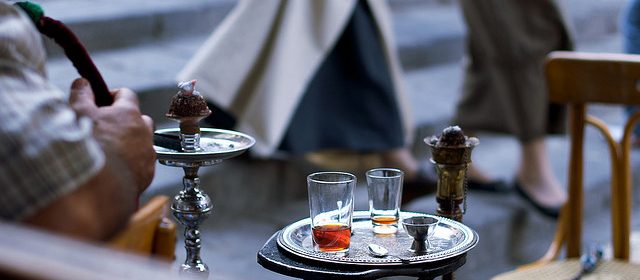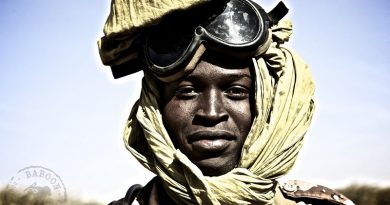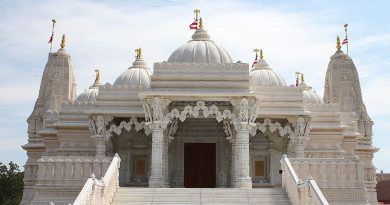Syrian Drinks: Repast in a Teacup
Food Facts
- Varieties: black tea, fresh mint tea, mate or thick, cardamom flavoured coffee for an instant hit of thick black caffeine.
- Top Tipple: Arak – similar to the Greek Ouzo – aniseedy and strong!
- Serving Suggestion: While away the hot afternoons in the souk with lots of mint tea, a nargila pipe and plenty of conversation.
Tea
 Tea and other beverages are an important part of Arabic culture. Invariably, during brisk negotiations in the souk, small glasses of extremely sweet tea will appear. The Arabic people, though world-class hagglers, never forget their famous hospitality.
Tea and other beverages are an important part of Arabic culture. Invariably, during brisk negotiations in the souk, small glasses of extremely sweet tea will appear. The Arabic people, though world-class hagglers, never forget their famous hospitality.
Black tea is the most common, usually the Lipton brand name. You can also find a delicious tea made from hibiscus flowers – zouhourat. This tea has a light yellow colour and a delicate, flowery flavour. It’s sometimes used for stomach upset also, and has a calming effect – whether this is physical or psychological is debatable, but it seems to work for the Arabs.
Most popular in Morocco, but also found through the Arab world is mint tea – which is green tea with mint leaves jammed in the glass, and a liberal sprinkle of sugar. Utterly delicious!
Coffee
Coffee, kahwa, is like the Turkish variety, brown, thick and strong, drunk in tiny espresso cups. It’s called “arabic coffee”, but it’s indistinguishable from the Turkish variety – most Arabs will probably tell you the same. After all, it was the Ottomans that brought it to this area when Europe was still struggling through the uncivilised Middle Ages. “American style” black coffee – kahwa amreekee – is usually watery, unexceptional Nescafe.
Syrians drink both shay and kahwa with plenty of sugar. Another type of coffee kahwa murrah is usually only seen when visiting private homes of older or more traditional Arabs. This is an extremely strong, hot coffee – that usually sits brewing all day in the living room on a small stove. It’s served in a traditional brass or silver Arabic coffee pot – you can find these actual pots in the souks everywhere.
When guests arrive at a home, tiny ceramic “shot glasses” come out, and a mouthful of this coffee is served to each guest. The guest accepts the coffee, whips it down like a shot and requests another if they’re feeling bold by shaking the glass slightly when handing it back to the host. This type of coffee is not drunk slowly and savoured, but just as a sort of quick “hello and welcome” shot of energy when entering a home. It’s also used at celebrations. At weddings, the bride and groom share their first swallow of coffee from the same cup, then smash the cups against the wall – bad luck for anyone else to drink from their cups.
Other Hot Beverages
Mate, originally an Argentinian drink, is popular in Syria, especially with Druze famillies. Most any social gathering will see people drinking Mate out of tiny cups with a distinctive “spoon-straw” utensil for sipping. A few spoonfuls of the dry, grassy leaves are put in a tiny cup, boiling water is poured over and a liberal amount of sugar. Only one person drinks the Mate at a time, passing the glass back when finished, and requesting another, or not. After that person is done, more boiling water is added, and sugar if necessary, and the cup is passed to the next person.
The birth of a baby, or other happy occasion will bring out the muggeli – a spicy, traditional tea with the taste of allspice and cinnamon, sometimes made with walnuts floating on top. Another hot drink is kammun, usually drunk in the winter containing cumin, salt and water.
Alcoholic Drinks
For the brave at heart, there is the Arab national drink – Arak. It’s much like the Turkish Raki or Greek Ouzo – with an aniseed taste, and it packs a punch. It’s not drunk right out of the bottle, but a small amount is poured into a tiny glass, water is then added and then ice – never add the ice before the water. The clear liquid turns white and cloudy, and then, yallah! It’s time to toast your host!
You can also find beer, bira, or mixed drinks (though these are somewhat rare) in most restaurants. Arabs are not big consumers of alcoholic beverages, and usually will only drink wine or beer when dining. There are not many bars as Americans would recognise them in the Arab world as drinking alcohol is forbidden in Islam. In Syria however, you fill find a mixture of cultures – Christian, Jewish and so on, so it is not always frowned upon but never bring a bottle of Arak to someone’s house if you are not sure if they are Muslim or not! You may unwittingly offend your host.
The exception to this is Lebanon, which has a flourishing Western-style nightlife scene, where beautiful, stylishly clad Lebanese drink and dance the night away, The Lebanese love to stay out all night and have fun! In Lebanon, you’ll find more establishments dedicated to drinking and socialising, but in Syria, most socialising is done in private homes, restaurants or tea and coffee houses.
Nargilas Pipes
Along with tea in the tea houses are nargilas – water pipes. These are smoked throughout the Arab world. In Egypt, they’re called sheesha, in Syria, nargilah. In Lebanon, Jordan and beyond, you’ll most likely use shisha or nargilah. The US variety is usually referred to as a hookah or Sheesha, in London, a “hubble bubble“. These pipes are not like smoking cigarettes or cigars (but it should be noted, carry the same health risks), and there are a number of cultural quirks that go along with the smoking. If you smoke cigarettes, NEVER, under any circumstances light your cigarette on the burning coal on top – this is considered very rude.
If you are smoking nargila with friends and would like the pipe to be passed to you, tap the hand of the smoker, and it will soon be passed to you. When passing the hose, do not point the metal tip at the receiver – again, considered quite rude. To be polite, you should fold the pipe over the hose and point the “curl” of the hose towards your neighbour when handing off the smoking end. The tobacco inside comes in a variety of flavours – most popular is strawberry, apricot and “double apple”, but there are also exotic varieties – watermelon, cappuccino, grape or chocolate to name a few.
The tobacco is drenched in a sweet, flavoured syrup – aluminium foil with holes covers the tobacco and a piece of burning wood coal, nara, goes on top. You can simply “taste” the smoke in your mouth, or inhale and fill you lungs – either way, nargilas are a traditionally Middle Eastern pastime. Arabs love to socialise – sit and chat in teahouses and while away the hours. For tourists, this makes for pleasant breaks from travelling while you get to know the natives – which is always enriching!




